Experimental Study on the Variation Pattern of Saline Ice Microstructure with Temperature
Abstract
1. Introduction
2. Field Experiments and Methods
2.1. Ice Physical Properties
2.2. Ice Microstructure
2.2.1. Volume Fraction
2.2.2. Size of Ice Microstructure
3. Results
3.1. Weather Conditions
3.2. Measurement of Ice Physical Properties
3.2.1. Ice Temperature
3.2.2. Ice Salinity and Density
3.3. Variation in Ice Microstructure
3.3.1. Variation in Volume Fraction
3.3.2. Variation in Ice Microstructure Size
3.4. Impact of Ice Temperature on Microstructure Size in Different Ice Layers
4. Discussion
4.1. Stratified Mechanisms of Temperature Response in Different Ice Layers and Their Microstructural Control Factors
4.2. Comparison with Other Studies
4.3. Limitations and Future Work
5. Conclusions
Author Contributions
Funding
Data Availability Statement
Conflicts of Interest
References
- Petrich, C.; Eicken, H. Overview of sea ice growth and properties. In Sea Ice; John Wiley & Sons, Ltd.: Chichester, UK, 2017; pp. 1–41. [Google Scholar]
- Hunke, E.; Notz, D.; Turner, A.; Vancoppenolle, M. The multiphase physics of sea ice. Sea 2011, 5, 1949–1993. [Google Scholar]
- Lund-Hansen, L.; Søgaard, D.; Sorrell, B.; Gradinger, R.; Meiners, K. Arctic Sea Ice Ecology; Springer: Berlin/Heidelberg, Germany, 2020. [Google Scholar]
- Yu, M.; Lu, P.; Cheng, B.; Leppäranta, M.; Li, Z. Impact of microstructure on solar radiation transfer within sea ice during summer in the Arctic: A model sensitivity study. Front. Mar. Sci. 2022, 9, 861994. [Google Scholar] [CrossRef]
- Golden, K.; Eicken, H.; Heaton, A.; Miner, J.; Pringle, D.; Zhu, J. Thermal evolution of permeability and microstructure in sea ice. Geophys. Res. Lett. 2007, 34, L16501. [Google Scholar] [CrossRef]
- Sandven, H.; Hamre, B.; Petit, T.; Röttgers, R.; Liu, H.; Granskog, M. Seasonality and drivers of water column optical properties on the northwestern Barents Sea shelf. Prog. Oceanogr. 2023, 217, 103076. [Google Scholar] [CrossRef]
- Thielke, L.; Huntemann, M.; Hendricks, S.; Jutila, A.; Ricker, R.; Spreen, G. Sea ice surface temperatures from helicopter-borne thermal infrared imaging during the MOSAiC expedition. Sci. Data 2022, 9, 364. [Google Scholar] [CrossRef]
- Kaleschke, L.; Tian-Kunze, X.; Hendricks, S.; Ricker, R. SMOS-derived Antarctic thin sea ice thickness: Data description and validation in the Weddell Sea. Earth Syst. Sci. Data 2024, 16, 3149–3170. [Google Scholar] [CrossRef]
- Zhang, Y.; Zhang, Y.; Guo, R.; Cui, B. Method for testing shear and tensile strengths of freshwater/seawater ice. Water 2022, 14, 1363. [Google Scholar] [CrossRef]
- Salomon, M.; Maus, S.; Petrich, C. Microstructure evolution of young sea ice from a Svalbard fjord using micro-CT analysis. J. Glaciol. 2022, 68, 571–590. [Google Scholar] [CrossRef]
- Light, B.; Maykut, G.; Grenfell, T. A temperature-dependent, structural-optical model of first-year sea ice. J. Geophys. Res. Ocean. 2004, 109, C06013. [Google Scholar] [CrossRef]
- Light, B.; Maykut, G.; Grenfell, T. Effects of temperature on the microstructure of first-year Arctic sea ice. J. Geophys. Res. Ocean. 2003, 108, 3051. [Google Scholar] [CrossRef]
- Crabeck, O.; Galley, R.; Mercury, L.; Delille, B.; Tison, J.; Rysgaard, S. Evidence of freezing pressure in sea ice discrete brine inclusions and its impact on aqueous-gaseous equilibrium. J. Geophys. Res. Ocean. 2019, 124, 1660–1678. [Google Scholar] [CrossRef]
- Cox, G.; Weeks, W. Equations for determining the gas and brine volumes in sea-ice samples. J. Glaciol. 1983, 29, 306–316. [Google Scholar] [CrossRef]
- Leppäranta, M.; Manninen, T. The Brine and Gas Content of Sea Ice with Attention to Low Salinities and High Temperatures; Finnish Institute for Marine Research: Helsinki, Finland, 1988. [Google Scholar]
- Bailey, D.; Holland, M.; DuVivier, A.; Hunke, E.; Turner, A. Impact of a new sea ice thermodynamic formulation in the CESM2 sea ice component. J. Adv. Model. Earth Syst. 2020, 12, e2020MS002154. [Google Scholar] [CrossRef]
- Perovich, D.; Gow, A. A quantitative description of sea ice inclusions. J. Geophys. Res. Ocean. 1996, 101, 18327–18343. [Google Scholar] [CrossRef]
- Cole, D.; Shapiro, L. Observations of brine drainage networks and microstructure of first-year sea ice. J. Geophys. Res. Ocean. 1998, 103, 21739–21750. [Google Scholar] [CrossRef]
- Frantz, C.; Light, B.; Farley, S.; Carpenter, S.; Lieblappen, R.; Courville, Z.; Orellana, M.; Junge, K. Physical and optical characteristics of heavily melted “rotten” Arctic sea ice. Cryosphere 2019, 13, 775–793. [Google Scholar] [CrossRef]
- Xie, F.; Lu, P.; Leppäranta, M.; Cheng, B.; Li, Z.; Zhang, Y.; Zhang, H.; Zhou, J. Heat budget of lake ice during a complete seasonal cycle in lake Hanzhang, northeast China. J. Hydrol. 2023, 620, 129461. [Google Scholar] [CrossRef]
- Liu, T.; Zhang, Y.; Li, Z.; Yu, M.; Xie, F.; Georgiy, K.; Yang, Z. Optical properties of ice in a shallow Chinese lake (Hanzhang) with consequent impacts on primary production. Sci. Total Environ. 2024, 957, 177512. [Google Scholar] [CrossRef]
- Stringer, C.; Wang, T.; Michaelos, M.; Pachitariu, M. Cellpose: A generalist algorithm for cellular segmentation. Nat. Methods 2021, 18, 100–106. [Google Scholar] [CrossRef]
- Shuman, C.; Hall, D.; DiGirolamo, N.; Mefford, T.; Schnaubelt, M. Comparison of near-surface air temperatures and MODIS ice-surface temperatures at Summit, Greenland (2008–2013). J. Appl. Meteorol. Climatol. 2014, 53, 2171–2180. [Google Scholar] [CrossRef]
- Lindsay, R.; Rothrock, D. Arctic sea ice surface temperature from AVHRR. J. Clim. 1994, 7, 174–183. [Google Scholar] [CrossRef]
- Stefan, J. Über die Theorie der Eisbildung, insbesondere über die Eisbildung im Polarmeere. Ann. Der Phys. 1891, 278, 269–286. [Google Scholar] [CrossRef]
- Smith, M.; Light, B.; Macfarlane, A.; Perovich, D.; Holland, M.; Shupe, M. Sensitivity of the Arctic sea ice cover to the summer surface scattering layer. Geophys. Res. Lett. 2022, 49, e2022GL098349. [Google Scholar] [CrossRef]
- Müller, R.; Pfeifroth, U. Remote sensing of solar surface radiation–a reflection of concepts, applications and input data based on experience with the effective cloud albedo. Atmos. Meas. Tech. 2022, 15, 1537–1561. [Google Scholar] [CrossRef]
- Zhao, J.; Zhang, S.; Jiao, Y.; Li, T. The shortwave solar radiation energy absorbed by packed sea ice in the central Arctic. Adv. Earth Sci. 2009, 24, 33–41. [Google Scholar]
- Marchenko, A.; Lishman, B. The influence of closed brine pockets and permeable brine channels on the thermo-elastic properties of saline ice. Philos. Trans. R. Soc. A Math. Phys. Eng. Sci. 2017, 375, 20150351. [Google Scholar] [CrossRef]
- Eicken, H. From the microscopic, to the macroscopic, to the regional scale: Growth, microstructure and properties of sea ice. In Sea Ice: An Introduction to Its Physics, Chemistry, Biology and Geology; Finnish Institute for Marine Research: Helsinki, Finland, 2003; pp. 22–81. [Google Scholar]
- Petrich, C.; Eicken, H. Growth, structure and properties of sea ice. In Sea Ice; Wiley-Blackwell: Hoboken, NJ, USA, 2010; Volume 2, pp. 23–77. [Google Scholar]
- Malm, J.; Terzhevik, A.; Bengtsson, L.; Boyarinov, P.; Glinsky, A.; Palshin, N.; Petrov, M. Temperature and salt content regimes in three shallow ice-covered lakes: 1. Temperature, salt content, and density structure. Hydrol. Res. 1997, 28, 99–128. [Google Scholar] [CrossRef]
- Kirillin, G.; Engelhardt, C.; Golosov, S.; Hintze, T. Basin-scale internal waves in the bottom boundary layer of ice-covered Lake Müggelsee, Germany. Aquat. Ecol. 2009, 43, 641–651. [Google Scholar] [CrossRef]
- Shatwell, T.; Thiery, W.; Kirillin, G. Future projections of temperature and mixing regime of European temperate lakes. Hydrol. Earth Syst. Sci. 2019, 23, 1533–1551. [Google Scholar] [CrossRef]
- Leppäranta, M. Structure and properties of lake ice. In Freezing of Lakes and the Evolution of Their Ice Cover; Springer: Berlin/Heidelberg, Germany, 2023; pp. 63–108. [Google Scholar]
- Xie, F.; Zhang, Y.; Lu, P.; Cao, X.; Zu, Y.; Li, Z. Characteristics and influencing factors of lake ice growth and decay in a shallow lake from a cold region. J. Lake Sci. 2021, 33, 1552–1563. [Google Scholar] [CrossRef]
- Huo, P.; Lu, P.; Xie, F.; Wang, Q.; Li, Z.; Arvola, L. Numerical simulation of the complete process of lake ice formation and melting in Lake Ulansu. Adv. Water Sci. 2024, 35, 145–155. [Google Scholar]
- Lei, R.; Li, Z.; Zhang, Z.; Cheng, Y. Comparisons of thermodynamic processes between lake ice and landfast sea ice around Zhongshan Station, East Antarctica. Chin. J. Polar Res. 2011, 23, 289. [Google Scholar]
- Yu, M.; Lu, P.; Zhang, H.; Zhang, G.; Wang, L.; Wang, Q.; Li, Z. Seasonal evolution of brackish ice microstructure during growth and decay processes. Cold Reg. Sci. Technol. 2025, 242, 104740. [Google Scholar] [CrossRef]
- Ladefoged, J. Microstructures and Compressive Strength of Lake Ice in Sweden A structural Documentation and Compressive Strength Analysis of Lake Ice Cores from Uppsala, Using the SonReb Method. Master’s Thesis, University of Gothenburg, Gothenburg, Sweden, 2023. [Google Scholar]
- Bock, C.; Eicken, H. A magnetic resonance study of temperature-dependent microstructural evolution and self-diffusion of water in Arctic first-year sea ice. Ann. Glaciol. 2005, 40, 179–184. [Google Scholar] [CrossRef]
- Lieb-Lappen, R.; Golden, E.; Obbard, R. Metrics for interpreting the microstructure of sea ice using X-ray micro-computed tomography. Cold Reg. Sci. Technol. 2017, 138, 24–35. [Google Scholar] [CrossRef]




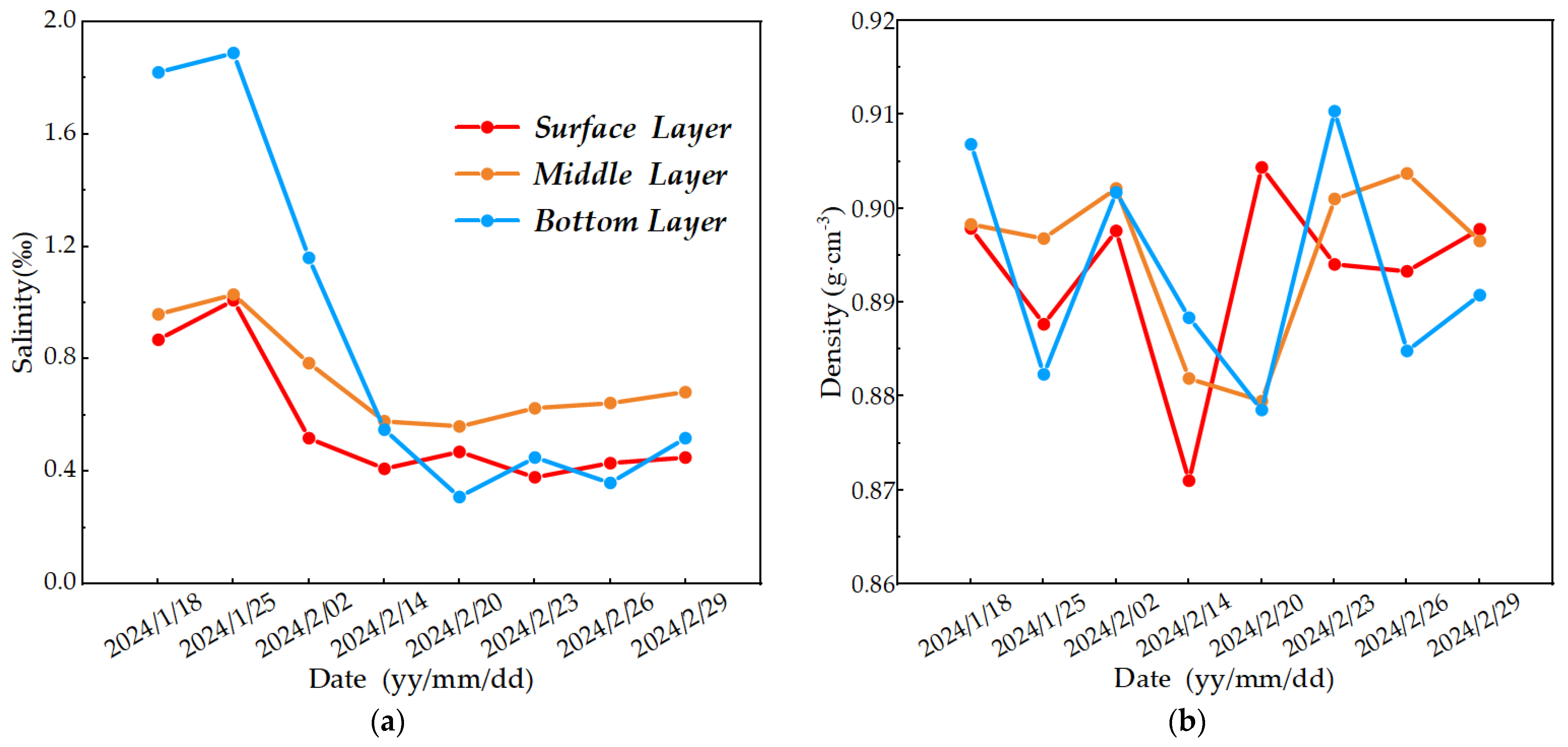

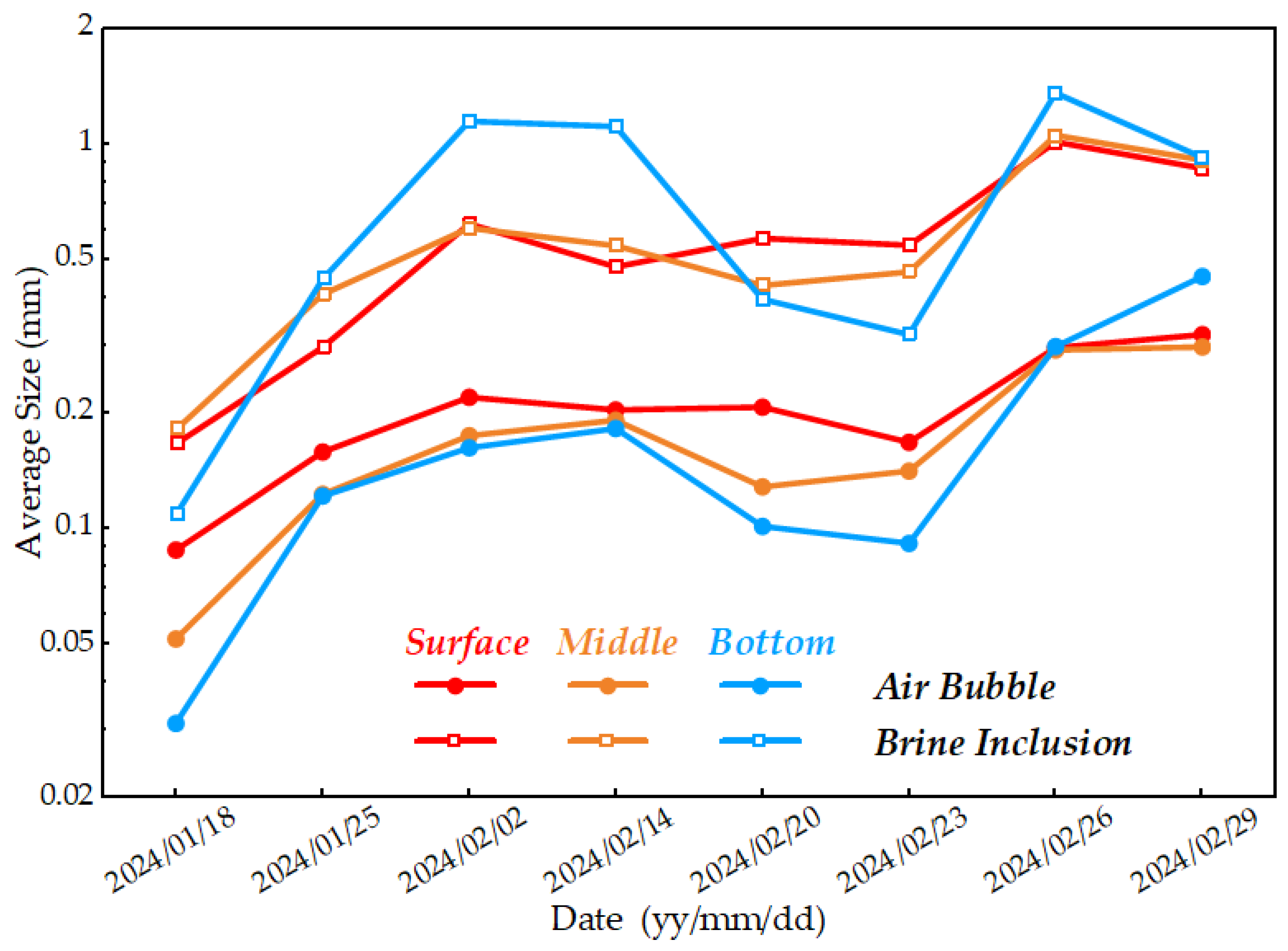

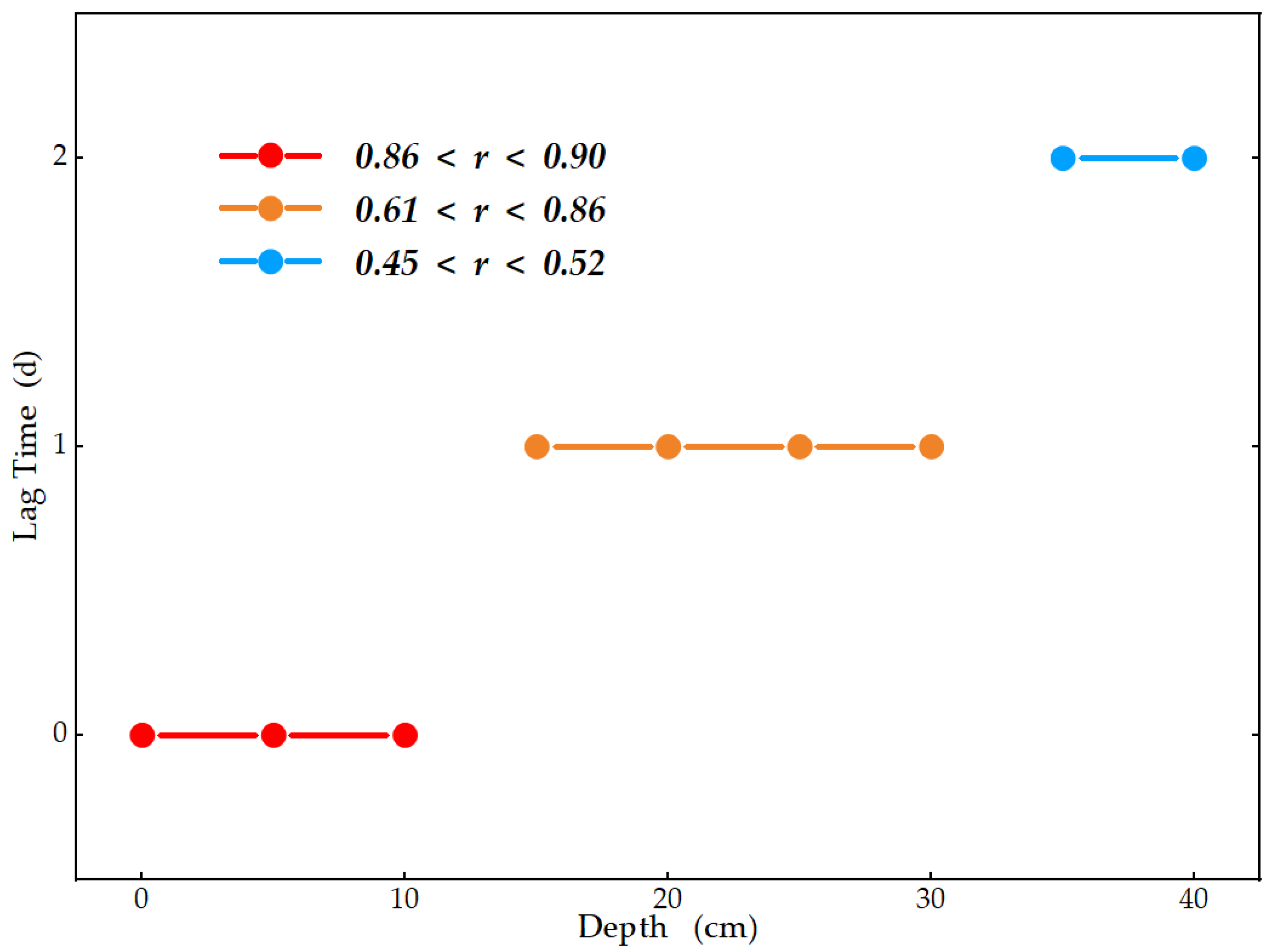
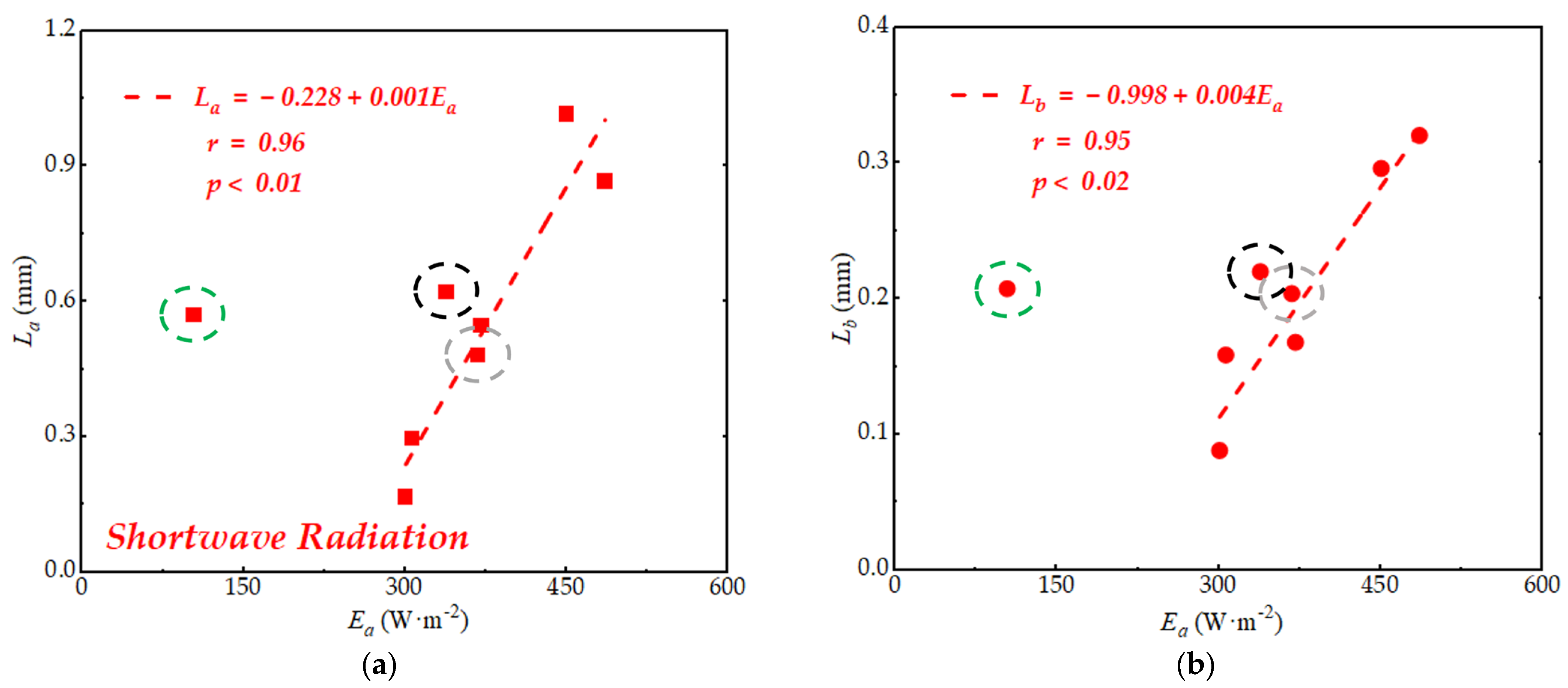
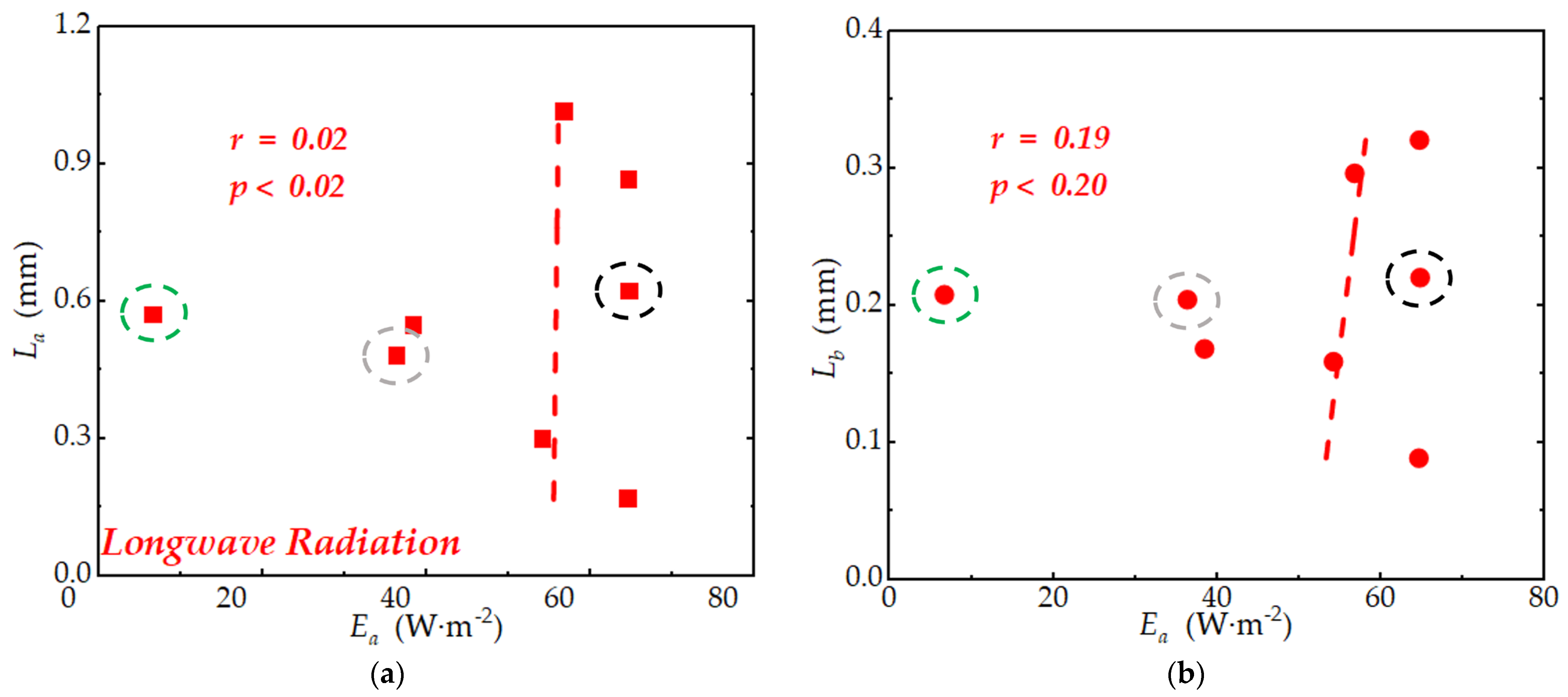
Disclaimer/Publisher’s Note: The statements, opinions and data contained in all publications are solely those of the individual author(s) and contributor(s) and not of MDPI and/or the editor(s). MDPI and/or the editor(s) disclaim responsibility for any injury to people or property resulting from any ideas, methods, instructions or products referred to in the content. |
© 2025 by the authors. Licensee MDPI, Basel, Switzerland. This article is an open access article distributed under the terms and conditions of the Creative Commons Attribution (CC BY) license (https://creativecommons.org/licenses/by/4.0/).
Share and Cite
Li, H.; Yu, M.; Lu, P.; Wang, Q. Experimental Study on the Variation Pattern of Saline Ice Microstructure with Temperature. Water 2025, 17, 3343. https://doi.org/10.3390/w17233343
Li H, Yu M, Lu P, Wang Q. Experimental Study on the Variation Pattern of Saline Ice Microstructure with Temperature. Water. 2025; 17(23):3343. https://doi.org/10.3390/w17233343
Chicago/Turabian StyleLi, Haokun, Miao Yu, Peng Lu, and Qingkai Wang. 2025. "Experimental Study on the Variation Pattern of Saline Ice Microstructure with Temperature" Water 17, no. 23: 3343. https://doi.org/10.3390/w17233343
APA StyleLi, H., Yu, M., Lu, P., & Wang, Q. (2025). Experimental Study on the Variation Pattern of Saline Ice Microstructure with Temperature. Water, 17(23), 3343. https://doi.org/10.3390/w17233343





